#ernst stromer
Text

spino 1
(ink on grey paper)
153 notes
·
View notes
Text
Spinosaurus, equipped with aquatic adaptations like crocodile-like jaws, webbed feet, has led some researchers to propose that it was predominantly an aquatic predator rather than a terrestrial one.
📹 : Julian Johnson-mortimer / Julian_johnson12345
—
Spinosaurus is a genus of spinosaurid dinosaur that lived in what now is North Africa during the Cenomanian to Upper Turonian stages of the Late Cretaceous period, about 99 to 93.5 million years ago.
The genus was first known from Egyptian remains discovered in 1912 and described by German palaeontologist Ernst Stromer in 1915.
The original remains were destroyed in World War II but additional material came to light in the early 21st century.
It is unclear whether one or two species are represented in the fossils reported in the scientific literature.
Spinosaurus, which was longer and heavier than Tyrannosaurus, is the largest known carnivorous dinosaur.
It possessed a skull 1.75 metres (roughly 6 feet) long, a body length of 14–18 metres (46–59 feet), and an estimated mass of 12,000–20,000 kg (13–22 tons).
#Spinosaurus#spinosaurid dinosaur#Late Cretaceous period#Ernst Stromer#carnivorous dinosaur#dinosaurs#paleontology#fossils
51 notes
·
View notes
Text

Spinosaurus (spine lizard) was a massive semi-aquatic predator from north Africa during the late Cretaceous period (99-93.5 Mya). The animal is thought to have measured about 49 feet, placing it among the largest theropod dinosaurs. Spinosaurus was originally discovered and named by German Paleontologist Ernst Stromer von Reichenbach in 1915. Tragically however, the original Spinosaurus skeleton, along with Stromer's other dinosaur specimens, were destroyed in a bombing of Munich during World War 2. Since then, more discoveries have been made, but recreating Spinosaurus is an ongoing puzzle.
Based on our current understanding of the animal, Spinosaurus had jaws similar to that of a crocodile, implying a diet of mostly fish. It had a thick paddle-like tail for swimming, and of course the iconic sail along its spine that gives it its name.
#spinosaurus#paleoart#paleontology#evolution#dinosaur#dinosaurs#birds#theropod#reptile#reptiles#animal#animals#animal art#zoology
29 notes
·
View notes
Text



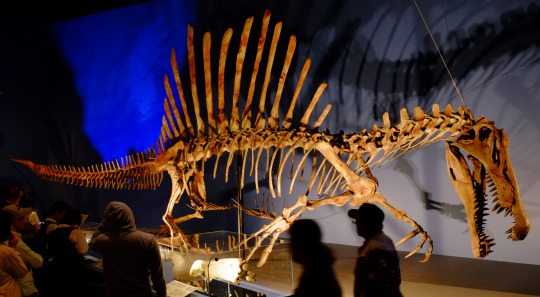
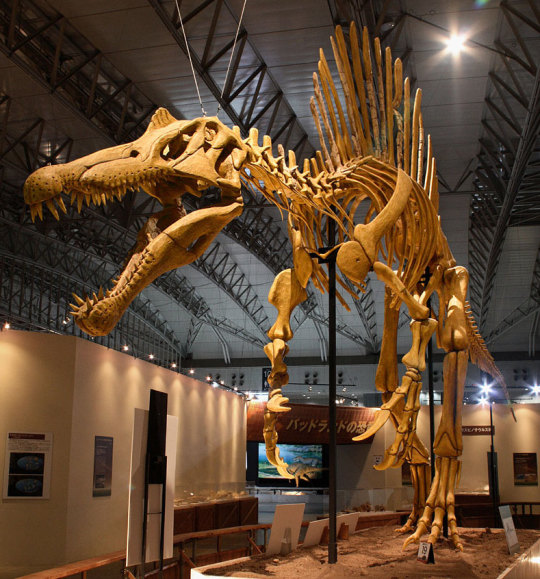
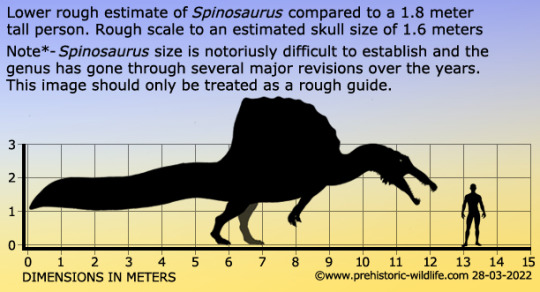
Spinosaurus
(temporal range: 99-93.5 mio. years ago)
[text from the Wikipedia article, see also link above]
Spinosaurus (/ˌspaɪnəˈsɔːrəs/; lit. 'spine lizard') is a genus of spinosaurid dinosaur that lived in what now is North Africa during the Cenomanian to upper Turonian stages of the Late Cretaceous period, about 99 to 93.5 million years ago.[2][3] The genus was known first from Egyptian remains discovered in 1912 and described by German palaeontologist Ernst Stromer in 1915. The original remains were destroyed in World War II, but additional material came to light in the early 21st century. It is unclear whether one or two species are represented in the fossils reported in the scientific literature. The best known species is S. aegyptiacus from Egypt, although a potential second species, S. maroccanus, has been recovered from Morocco. The contemporary spinosaurid genus Sigilmassasaurus has also been synonymized by some authors with S. aegyptiacus, though other researchers propose it to be a distinct taxon. Another possible junior synonym is Oxalaia from the Alcântara Formation in Brazil.
Spinosaurus is the longest known terrestrial carnivore; other large carnivores comparable to Spinosaurus include theropods such as Tyrannosaurus, Giganotosaurus and Carcharodontosaurus. The most recent study suggests that previous body size estimates are overestimated, and that S. aegyptiacus reached 14 metres (46 ft) in length and 7.4 metric tons (8.2 short tons) in body mass.[4] The skull of Spinosaurus was long, low, and narrow, similar to that of a modern crocodilian, and bore straight conical teeth with no serrations. It would have had large, robust forelimbs bearing three-fingered hands, with an enlarged claw on the first digit. The distinctive neural spines of Spinosaurus, which were long extensions of the vertebrae (or backbones), grew to at least 1.65 meters (5.4 ft) long and were likely to have had skin connecting them, forming a sail-like structure, although some authors have suggested that the spines were covered in fat and formed a hump.[5] The hip bones of Spinosaurus were reduced, and the legs were very short in proportion to the body. Its long and narrow tail was deepened by tall, thin neural spines and elongated chevrons, forming a flexible fin or paddle-like structure.
Spinosaurus is known to have eaten fish, and most scientists believe that it hunted both terrestrial and aquatic prey. Evidence suggests that it was semiaquatic; how capable it was of swimming has been strongly contested. Spinosaurus's leg bones had osteosclerosis (high bone density), allowing for better buoyancy control. Multiple functions have been put forward for the dorsal sail, including thermoregulation and display; either to intimidate rivals or attract mates. It lived in a humid environment of tidal flats and mangrove forests alongside many other dinosaurs, as well as fish, crocodylomorphs, lizards, turtles, pterosaurs, and plesiosaurs.
9 notes
·
View notes
Text
Spinosaurus was a member of the spinosaurid genis of dinosaurs that lived in what is now North America. They roamed the earth from the Cenomanian to the Turonian stages of the late Cretaceous period from 99 to 93.5 million years ago.
It was 12.6 to 18 meters long, 4.9 to 7.7 meters tall, and weighed anywhere from 13 to 22 tons. It also has the shortest legs out of any theropod dinosaur.
Much like it's relative the baryonyx it was an aquatic dinosaur which meant it's diet consisted coelacanths, sawfish, large lung fish, and sharks which lived in the dinosaurs river system.
It was discovered in 1912 by Richard Markgraf who found a partial specimen in Egypt's Bahari Oasis. After excavation was complete the fossils were sent to Ernst Stromer in Germany for study and later in 1915 the specimen was named Spinosaurus, meaning, "Spine lizard of Egypt."
1 note
·
View note
Text
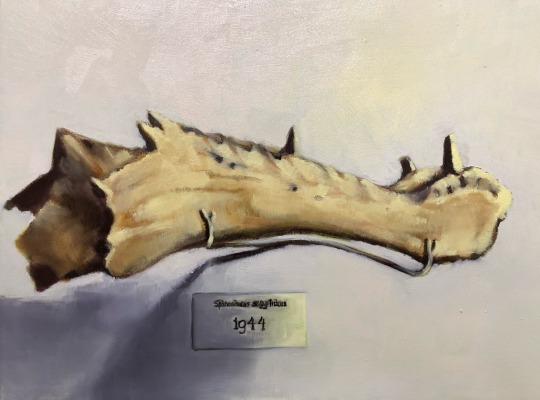
4/19/22
#art#painting#paleontology#scientific illustration#oil painting#paleoart#dinosaur#dinosaurs#oil on panel#artwork#fine art#original art#spinosaurus#Ernst Stromer#germany#ww2#destruction#spinosauridae
175 notes
·
View notes
Photo
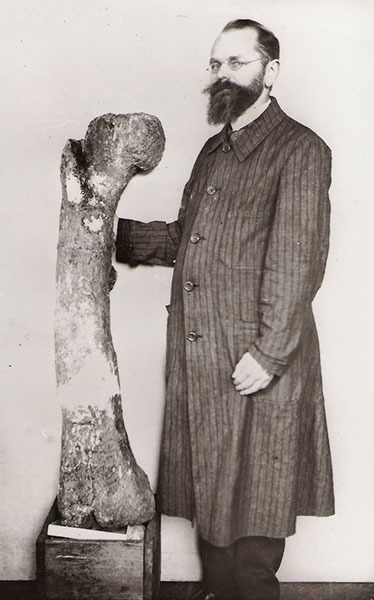




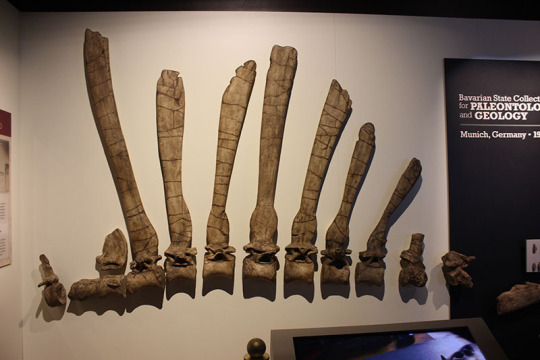

Ernst Stromer – Scientist of the Day
Ernst Stromer, a German paleontologist, died Dec. 18, 1952, at the age of 81.
read more...
#Ernst Stromer#paleontology#Egypt#Spinosaurus#histsci#histSTM#20th century#history of science#Ashworth#Scientist of the Day
171 notes
·
View notes
Text

#dinosaur#dinosaurs#dino#spinosaurus#spinosaurus art#aegyptiacus#spinosaurus aegyptiacus#ernst stromer#cretaceous#dinosaur art#fish eating dinosaur#dinosaur eating shark#hershel hoffmeyer#artist#deviantart#deviantartist#a dragon's grace#a dragons grace#shark#Onchopristis#piscivorous
17 notes
·
View notes
Text


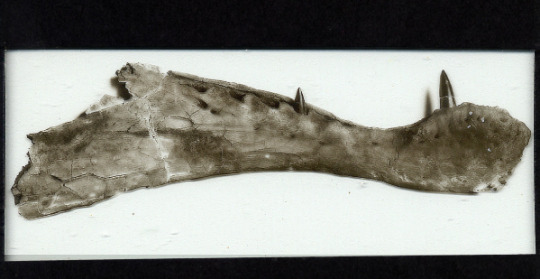
Let's just all take a second to remember the German paleontologist Ernst Freiherr Stromer von Reichenbach. He was the first to discover Spinosaurus aegyptiacus, a semi aquatic carnivore that is approx. 49-52 ft in length and ~7 1/2 tonnes, with spines around 5.4 ft high. Today in 1944, hundreds of allied bombers dropped thousands of bombs on Munich, which was where his research was held. The museum was destroyed and so was the only remains of the world's largest carnivorous dinosaur. Spinosaurus was lost to history. These are one of the few surviving image of Stromer's Spinosaurus skeleton. While Stromer died in 1952, his journals and photographs survive, but without skeletons to grace exhibit halls or fossils to study his dinosaurs are overshadowed by others. He was essentially forgotten. But let's remember his amazing contributions to the field of paleontology. And shout out to Nizar Ibrahim who helped revive Stromer's legacy.
#Spinosaurus aegyptiacus#Spinosaurus#Nizar Ibrahim#paleontology#Ernst Stromer#history#dino#dinosaurs#Also today is my mom's bday#thatsageukgat
61 notes
·
View notes
Text


i know i cant fault them since it was published in 2012, but seeing this hurts my heart
#they ONLY had the head and a few spines#and i think a femur? partial femur?#and for the longest time the only remains were destroyed in the war#so they only had ernst stromer’s description of it to do off of#2014 i think??? was when they found more substantianal pieces of it#i also want to mention that they knew it hunted aquatic life was because of the teeth! they didnt really know much beyond that#they just thought it looked like every other theropod#personal i guess
2 notes
·
View notes
Text
Monday 12/7/21 - Palaeontology's History of Spinosaurus

Spinosaurus over the decades, Mario Lanzas
In a strange twist of fate, being very deeply obsessed with Dinosaurs as an adult means that it's a lot harder to choose a favourite Dinosaur. I have a few I hold higher than most species, and one of those is Spinosaurus.
Spinosaurus is a very unique animal, even among Dinosauria. It was thought to be the largest meat-eating dinosaur, and also the most aquatically adapted dinosaur. Despite being such a mainstream dinosaur, Spinosaurus is only known from a handful of specimens, and none of them have been close to 100% complete. This has meant that every time we find new remains, we often find something we never knew about the dinosaur before.
In today's article, I'm gonna go over a brief history of Spinosaurus discoveries and how we thought it looked at the time.
1912 - Holotype
Although there are many intricate unique parts to its anatomy, the first and most striking thing about it is the tall neural spines on its back, and this became its namesake, Spinosaurus. In 1912, the first remains of Spinosaurus were discovered in the Bahariya formation, Egypt, and named by Ernst Stromer in 1915.
The full species name was Spinosaurus aegyptiacus, meaning Egyptian Spine Lizard. This specimen became the Holotype, which means this specimen is what all future specimens would refer to when deciding if remains belong to Spinosaurus aegyptiacus.

Original Skeletal remains, as reconstructed by Stromer. The bones actually found highlighted in black.
Since the Holotype lacked the top of the skull, Spinosaurus was originally reconstructed with a more typical therapod head, and also more upright, as was standard with meat eating dinosaur reconstructions at that time.

Spinosaurus, Terry Riley
Stromer's Spinosaurus skeleton was destroyed during a bombing raid in WW2 that destroyed part of Berlin Museum, so modern Palaeontological techniques cannot be used to uncover more information about that particular set of remains.
1998 - New Century Spinosaurus
Some very fragmentary remains of Spinosaurus was found over the 20th Century, but nothing substantial enough to inform palaeontologists about more of Spinosaurus's anatomy, until 1998.
Although these remains were still very incomplete compare to many other popular dinosaurs, we now had part of the upper jaw. Scientists could now group Spinosaurus with other similar crocodile headed dinosaurs, especially Baryonyx, described in 1986. This new Spinosaurus was tentatively given its own species, S. marrocanus, but most scientists do not consider the species valid, and lump it together with S. aegyptiacus.

Left: Upper jawbone of Spinosaurus described by Taquet, and Russell.
Right: Skeletal remains of Baryonyx (top) Suchomimus (middle), 1998 Spinosaurus (bottom)
Since 1998's Spinosaurus was just a sized-up Baryonyx with a large dorsal sail, it became a very exciting dinosaur. Spinosaurus was now taller, heavier and longer than Tyrannosaurus rex. This popularity peaked with Jurassic Park 3, which was based on this reconstruction.

Below: Jurassic Park 3 Spinosaurus, NikoRex (DeviantArt)
2014 - The Aquatic Neotype
In 2014, a new skeleton of Spinosaurus was found in Morocco, and it was the most complete skeleton yet. Not only did we have almost a complete skull, but we had a full neck, several neural spines, and LIMBS! The completeness of this specimen has made it the Neotype (the new Holotype which we compare Spinosaurus remains to).
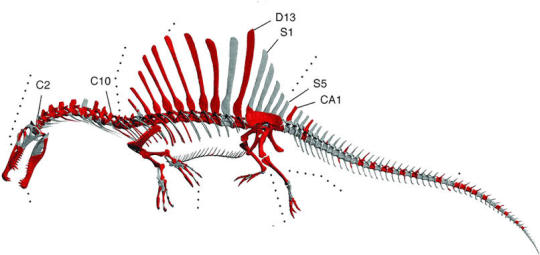
2014 reconstruction of Spinosaurus, actual bones in red
Ibrahim et al's description of Spinosaurus aegypticus revolutionised how we reconstructed Spinosaurus. The legs recovered from this specimen revealed that they were way... smaller than what we'd expect of a dinosaur it's size. Based on the maths of trying to balance Spinosaurus, reconstructions of the 2014 specimen had concluded that Spinosaurus was too front-heavy to be bipedal on land.

Facultative Quadrupedal Spinosaurus, Davide Bonadonna
Thus began the new age of the river monster Spinosaurus, who spent a lot of time in the water and knuckle-walked on all fours while on land.
2020 - The Tail
You may have noticed in all the skeletal remains diagrams I've posted so far, the tail has never been anywhere near complete. That changed in 2020, when Ibrahim and company returned to the site of the 2014 discovery and found more bones, this time of a truly unique tail seen nowhere else in the dinosaur clade.

2020 Spinosaurus, remains found in red, green, and yellow, bones never found previously in green.
This new tail discover all but confirms an aquatic lifestyle for Spinosaurus, as this new tail also had taller spines that would have supported a Newt or Crocodile-like tail paddle in life.
Also for the knuckle-walk haters, this tail would've overbalanced Spinosaurus wayyyy in the other direction. Spinosaurus was not only definitely bipedal again, but it probably walked more upright that any other of its close relatives, or most therapods in general.

2020 Spinosaurus, Mark Witton.
As of writing, no more major overhauls in what we know of Spinosaurus's anatomy have been proposed. But there are new possibilities just waiting to be discovered.
To put it in perspective for a second, there have been about 50 partial to full skeletons described of Tyrannosaurus rex, so our understanding of what that dinosaur looks like is pretty set in stone. There have been less than 10 partial remains described of Spinosaurus, maybe 2 of them are complete enough to give a good picture of the full animal, and the Holotype was destroyed by bombs.
Part of why Spinosaurus is among my favourite dinosaurs is because how unique it is. Part of it is that new stuff about the animal is being found all the time.
Thanks for reading
Hope you enjoyed the read. If there's anything you wanna correct me on, feel free. I'm not a palaeontologist, just a dinosaur enthusiast, so there's bound to be stuff I got wrong. If you wanna suggest another article topic on dinosaurs, my asks and inbox are open.
745 notes
·
View notes
Text
The Strange Saga of Spinosaurus, the Semiaquatic Dinosaurian Superpredator
I’ve been captivated by dinosaurs for as long as I can remember. My parents tell me that I told them that I wanted to be a paleontologist as early as age four. Naturally, then, I had lots and lots of books about dinosaurs when I was a boy growing up during the 1980s. One of the dinosaurs that always fascinated me the most was Spinosaurus aegyptiacus. Found in 1912 in the Bahariya Oasis of the Western Desert of Egypt (could anyplace sound more exotic to a small-town kid from upstate New York?!), Spinosaurus was originally known from a highly incomplete but also very large and extremely distinctive partial skeleton found in a middle Cretaceous-aged (roughly 95-million-year-old) rock layer in the oasis. Among the few skeletal elements known were part of a strangely shaped (for a dinosaur) lower jaw, some crocodile-like teeth, and most strikingly, several back vertebrae that each sported tall spines, some of them measuring nearly six feet. These spines clearly impressed Ernst Stromer von Reichenbach, the German paleontologist who studied the skeleton and gave the animal its name in a 1915 publication. Tragically, however, that original Spinosaurus skeleton—and all of Stromer’s other dinosaur fossils from Egypt—were destroyed during the Second World War, more specifically in a British Royal Air Force bombing of Munich on April 24, 1944. The story of Stromer’s lost dinosaurs found its way into many a children’s book, including several that I read cover-to-cover. As such, the tale took on near-legendary status for me, and, I’m sure, many other young dinosaur enthusiasts around the world. Here was an absolutely extraordinary dinosaur from a faraway land, similar in size to the gargantuan Tyrannosaurus rex, but clearly very different from all other predatory dinosaurs known at the time – and it was represented only by a few teeth and bones that had been blasted into oblivion decades ago and so now existed only as pictures in books.

A scan of my photocopy of plate I of Ernst Stromer’s original 1915 publication on Spinosaurus aegyptiacus, showing some of the teeth and bones preserved in the holotype (= name-bearing) partial skeleton, discovered in 1912 in Egypt’s Bahariya Oasis. Check out the long spines on the back vertebrae at lower left!

Stromer’s conception of Spinosaurus, as depicted in a 1936 publication and on a glass slide of his that colleagues of mine scanned during our visit to the Paläontologisches Museum München in Munich, Germany in 2001. Stromer knew this animal was big, as evidenced by the human skeleton he included for scale. Interestingly, too, he reconstructed Spinosaurus with unusual proportions for a carnivorous dinosaur, such as an abnormally elongate torso and short hind limbs. We’ll come back to those odd proportions a little later…
When I arrived in graduate school at the University of Pennsylvania in 1997, one of the first things I did was make a lengthy list of all the paleontological sites I was interested in exploring, ranked by their potential (in my mind, at least) to produce scientifically significant finds. The Bahariya Oasis and the search for a ‘replacement Spinosaurus’ quickly rose to the top of the list. Amazingly, no one had ever found—or at least officially reported—new dinosaur fossils in the oasis in the more than half-century since Stromer’s beasts were obliterated during that fateful airstrike. A need to keep this post to a reasonable length prevents me from describing the stars that had to align to make this happen, but in January 2000 I found myself in the Bahariya Oasis—one of the places I’d dreamed about going since I was a small child—as part of the first significant ‘dinosaur hunt’ to take place at the site since the early 20th century. It was bittersweet, though, in the sense that we never really found that ‘replacement Spinosaurus’ I’d fantasized about – all we ever discovered of that creature were a few isolated, fragmentary teeth and bones (and, in a very different location, a couple previously unpublished photos of the original skeleton in a Munich archive). We did find and dig up a gigantic new species of long-necked, plant-eating sauropod dinosaur, Paralititan stromeri, a creature that to this day is one of the largest land animals of any kind that’s ever been found, anywhere – but that’s another story for another time.

One of the rare contributions that I personally have made to scientific knowledge of Spinosaurus: a glass slide showing the only known photo of the right dentary (tooth-bearing lower jaw bone) of the original, name-bearing partial skeleton from Egypt. Like all of Stromer’s Egyptian dinosaur material, this specimen (including this bone) was destroyed in a British air raid on Munich during World War II. Several colleagues and I ‘rediscovered’ this photo—which nobody apparently knew existed—in an archive at the Paläontologisches Museum München in 2001. We published it and one other previously unknown photo of the Spinosaurus type specimen in a 2006 paper in the Journal of Paleontology.

A much younger yours truly digging up the incomplete left humerus (upper arm bone) of the gigantic sauropod (long-necked herbivorous dinosaur) Paralititan stromeri in the Bahariya Oasis of Egypt, February 2000. Paralititan is one of the largest dinosaurs ever discovered – a nice ‘consolation prize’ given that we didn’t find much of Spinosaurus during our expeditions to Bahariya. (A cast replica of the complete right humerus of Paralititan is on display in PaleoLab at Carnegie Museum of Natural History.) Credit: Josh Smith.
Back to the matter at hand, meaning Spinosaurus. Fast-forward to 2011. I had the honor of serving as the external thesis examiner for Nizar Ibrahim, a promising doctoral student at University College Dublin in Ireland. I’d known Nizar for years, ever since he reached out to me by email while an undergraduate at the University of Bristol, England, to discuss our mutual interests in African Cretaceous dinosaurs. Nizar’s Ph.D. thesis was on dinosaurs and other middle Cretaceous-aged vertebrates from the celebrated Kem Kem beds of southeastern Morocco, a set of rocks that had yielded a fossil fauna very similar to, though seemingly more diverse than, that of the Bahariya Oasis. Among the many finds that Nizar documented in his colossal thesis were intriguing new remains of Spinosaurus. I went to Dublin to participate in his successful thesis defense, and afterward, he and I hit up some of the city’s finest public houses to celebrate (no surprise for those who know me). Over a pitcher of yummy Irish stout, he told me an exciting story – he and his team had lately discovered not just isolated bones of Spinosaurus in Morocco, but parts of a probable new skeleton. If so, this find would be the first skeleton since Stromer, and moreover would be exceedingly important given how little was known about Spinosaurus, even as recently as the early 2010s. The more parts we paleontologists have of a given fossil animal, the more we can generally learn about it, so the prospect of a new and relatively complete Spinosaurus skeleton—in other words, many bones belonging to a single individual dinosaur—was thrilling to say the least.
Again I’ll skip details for brevity’s sake, but fast-forward once again, to 2014. I was contacted by an editor of Science—one of the foremost scientific journals in the world—to peer-review a paper that had been submitted by (you guessed it!) Nizar and a long list of collaborators describing that new skeleton of Spinosaurus that he’d told me about over beers in Ireland three years before. Nizar and team had revisited the quarry and it had panned out in a big way. From this one, single individual Spinosaurus—again, the first associated skeleton of this dinosaur to have been found in roughly a century—they had bones from the skull, backbone (including a few of those famously long-spined vertebrae!), forelimb, pelvis, and hind limb. More importantly, these ‘new’ bones revealed that Spinosaurus was even more bizarre than anyone imagined! We already knew, from Stromer’s specimen and other, isolated finds made through the years, that the shapes of the skull and back were really weird for a predatory dinosaur. Now, the new skeleton showed that the bones were remarkably dense, the hind legs were oddly short, and the hind feet may have been webbed! All of this led Nizar and colleagues to propose that Spinosaurus may have been semiaquatic; in other words, that its lifestyle was much more comparable to that of a modern-day alligator or crocodile than it was to a more ‘typical’ land-living predatory dinosaur such as T. rex. Other evidence for an affinity to watery habitats had been found in Spinosaurus and closely related dinosaurs (known, perhaps unsurprisingly, as spinosaurids) before, but this was, in my mind, the most convincing case yet made that these animals spent significant amounts of their time at least partly submerged in lakes and rivers. The paper was published in Science a few months later, accompanied by a cover story in National Geographic magazine and a special on the venerable PBS TV series NOVA. Almost exactly one hundred years after it had been named, Spinosaurus had become a celebrity.

Nizar Ibrahim and colleagues’ initial conception of Spinosaurus aegyptiacus in the flesh, released to coincide with the publication of their Science paper in 2014. Two aspects stand out: as Stromer already knew (see his skeletal reconstruction above), the animal is enormous, but it was more oddly proportioned than even he had imagined. Note also the ‘regular-looking’ (for a dinosaur) tail, and read on. Credit: Davide Bonadonna.

Semiaquatic Spinosaurus chowing down on a tasty lungfish in what is now northern Africa some 95 million years ago. Italian paleoartist Davide Bonadonna has produced some of the most beautiful and accurate modern depictions of this extraordinary dinosaur, and I’m grateful to him for letting me reproduce his art here.
But the story didn’t end there. Some prominent paleontologists criticized Nizar and colleagues’ semiaquatic interpretation of Spinosaurus. These opinions weren’t a final judgment. Instead, this is just how science works: we scientists propose ideas, or hypotheses—in this case, that Spinosaurus lived and behaved more like a crocodile than your garden-variety carnivorous dinosaur—and then test these hypotheses by reevaluating the existing evidence and/or bringing new information to light. If a hypothesis repeatedly stands up to testing, then it gradually gets incorporated into the body of knowledge. Other paleontologists presented evidence that they claimed refuted the semiaquatic hypothesis, but Nizar and team eventually countered with new data of their own. In late 2019, another prominent scientific journal—this time it was Nature—came calling, asking me to review a second paper by Nizar et al. on Spinosaurus. What, I thought, could these researchers have to say about this dinosaur that they hadn’t already said before? Well, as it turns out, Nizar and colleagues had kept digging at their Spinosaurus skeleton site, and incredibly, they’d continued to find important new bones belonging to the same specimen. Among these post-2014 finds was the almost complete tail. When I saw what it looked like (via an illustration in their paper), I literally laughed out loud with surprise and delight. Somehow, the shape of the Spinosaurus tail Nizar’s team had discovered—the first even reasonably complete tail of this dinosaur to have ever been unearthed—was simultaneously both unexpected and predictable. It looked really dissimilar from the tails of other predatory dinosaurs, but it was nearly exactly like what one might expect for a dinosaur that used its tail to propel itself through water. In other words, the tall, fin-like tail of Spinosaurus looked more like that of a supersized alligator or newt than that of T. rex.
Nizar and team’s Nature paper on their Spinosaurus tail was published this past April 29. Is it the last word on this dinosaur and its mode of life? Most certainly not, but the evidence is now stronger than ever—in my opinion, very strong—that Spinosaurus spent more time in the water than any other non-avian (= non-bird) dinosaur that we currently know about.

The modern view of Spinosaurus, not as a ‘regular’ predatory dinosaur, but rather as a specialized semiaquatic hunter that spent much of its life in the water. Self-serving side note: the three smaller, spiky-looking fish are Bawitius bartheli, a polypterid (an archaic, still-extant group of thick-scaled ray-finned fishes) that several colleagues and I named in 2012 from fossils found in the Bahariya Oasis. The larger fish at lower left is the giant coelacanth Axelrodichthys (sometimes called Mawsonia) libyca. Credit: Davide Bonadonna.

Two Spinosaurus invite the sawfish Onchopristis numidus to lunch in what’s now northern Africa some 95 million years ago. Look at those fin-like Spinosaurus tails! Credit: Davide Bonadonna/National Geographic.
Nizar (who’s a Research Associate here at Carnegie Museum of Natural History), myself, and our many colleagues and collaborators are continuing to study the mysterious dinosaurs and other fossil vertebrates from the middle and Late Cretaceous of northern Africa. Indeed, Nizar and I have several collaborative papers in the works right now, and I’m also working with an amazing team of paleontologists at Mansoura University on multiple new Egyptian fossil finds. It’s a good bet that African Cretaceous dinosaurs even stranger than Spinosaurus are still out there, waiting to be discovered!
Further reading/watching:
Nothdurft, W. E., with J. B. Smith, M. C. Lamanna, K. J. Lacovara, J. C. Poole, and J. R. Smith. 2002. The Lost Dinosaurs of Egypt. Random House, New York, 256 pp.
Smith, J. B., M. C. Lamanna, H. Mayr, and K. J. Lacovara. 2006. New information regarding the holotype of Spinosaurus aegyptiacus Stromer, 1915. Journal of Paleontology 80:400–406.
Ibrahim, N., P. C. Sereno, C. Dal Sasso, S. Maganuco, M. Fabbri, D. M. Martill, S. Zouhri, N. Myhrvold, and D. A. Iurino. 2014. Semiaquatic adaptations in a giant predatory dinosaur. Science 345:1613–1616.
Bigger Than T. rex (NOVA documentary): https://www.pbs.org/wgbh/nova/video/bigger-than-t-rex/
Henderson, D. M. 2018. A buoyancy, balance and stability challenge to the hypothesis of a semi-aquatic Spinosaurus Stromer, 1915 (Dinosauria: Theropoda). PeerJ 6:e5409.
Ibrahim, N., S. Maganuco, C. Dal Sasso, M. Fabbri, M. Auditore, G. Bindellini, D. M. Martill, S. Zouhri, D. A. Mattarelli, D. M. Unwin, J. Wiemann, D. Bonadonna, A. Amane, J. Jakubczak, U. Joger, G. V. Lauder, and S.E. Pierce. 2020. Tail-propelled aquatic locomotion in a theropod dinosaur. Nature 581:67–70.
Matt Lamanna is Mary R. Dawson Associate Curator and Head of the Section of Vertebrate Paleontology at Carnegie Museum of Natural History. Museum staff, volunteers, and interns are encouraged to blog about their unique experiences and knowledge gained from working at the museum.
142 notes
·
View notes
Photo

Is a genus of spinosaurid dinosaur that lived in what now is North Africa during the Cenomanian to upper Turonian stages of the Late Cretaceous period, about 99 to 93.5 million years ago. This genus was known first from Egyptian remains discovered in 1912 and described by German palaeontologist Ernst Stromer in 1915. The original remains were destroyed in World War II, but additional material has come to light in the early 21st century. It is unclear whether one or two species are represented in the fossils reported in the scientific literature. The best known species is S. aegyptiacus from Egypt, although a potential second species, S. maroccanus, has been recovered from Morocco. The contemporary spinosaurid genus Sigilmassasaurus has also been synonymized by some authors with S. aegyptiacus, though other researchers propose it to be a distinct taxon. Another possible junior synonym is Oxalaia from the Alcântara Formation in Brazil. Spinosaurus was among the largest of all known carnivorous dinosaurs, nearly as large as or even larger than other theropods such as Tyrannosaurus, Giganotosaurus and Carcharodontosaurus. Estimates published in 2005, 2007, and 2008 suggested that it was between 12.6 to 18 meters (41 to 59 ft) in length and 7 to 20.9 metric tons (7.7 to 23.0 short tons) in weight. New estimates published in 2014 and 2018, based on a more complete specimen, supported the earlier research, finding that Spinosaurus could reach lengths of 15 to 16 meters (49 to 52 ft). The latest estimates suggest a weight of 6.4 to 7.5 metric tons (7.1 to 8.3 short tons).[8][9] The skull of Spinosaurus was long, low and narrow, similar to that of a modern crocodilian, and bore straight conical teeth with no serrations. It would have had large, robust forelimbs bearing three-fingered hands, with an enlarged claw on the first digit. The distinctive neural spines of Spinosaurus, which were long extensions of the vertebrae (or backbones), grew to at least 1.65 meters (5.4 ft) long and were likely to have had skin connecting them, forming a sail-like structure, although some authors[who?] have suggested that the spines were covered in fat and formed a hump. Spinosaurus's hip bones were reduced, and the legs were very short in proportion to the body. Its long and narrow tail was deepened by tall, thin neural spines and elongated chevrons, forming a flexible fin or paddle-like structure. Spinosaurus is known to have eaten fish, and most scientists believe that it hunted both terrestrial and aquatic prey. Evidence suggests that it was highly semiaquatic, and lived both on land and in water as modern crocodilians do. Spinosaurus's leg bones had osteosclerosis (high bone density), allowing for better buoyancy control, and the paddle-like tail was likely used for underwater propulsion. Multiple functions have been put forward for the dorsal sail, including thermoregulation and display; either to intimidate rivals or attract mates. Spinosaurus lived in a humid environment of tidal flats and mangrove forests alongside many other dinosaurs, as well as fish, crocodylomorphs, lizards, turtles, pterosaurs, and plesiosaurs.
Carnivore
Spinosaurus (c) Jurassic Park III
Art (c) reneg661
4 notes
·
View notes
Text
Animal Crossing Fish - Explained #83
Brought to you by a marine biologist with the winner again...
CLICK HERE FOR THE AC FISH EXPLAINED MASTERPOST!
We had another vote and the majority of people wanted to see me cover Spinosaurus, the only true dinosaur we will be covering in these AC Fish Explained posts. But...why cover it at all? Well first of all, watch your tongue - dinosaurs are cool, so why not??? But also because, despite the fact that mostly all dinosaurs lived strictly on land, Spinosaurus and its relatives were well-adapted to catching fish and may have been great swimmers.

The Spinosaurus fossil comes in three parts that, by now, I imagine everyone who’s been playing this game since the pandemic began has gotten already. You might also notice that the fossil’s tail is already out of date! Science in action!!!
ACNH does a fairly good job (and I say fairly because there are some glaring mistakes in their tree of life) of keeping groups together. The dinosaurs in this section are known as Theropods, which were generally carnivorous, two-legged dinos (although there are exceptions) that eventually gave rise to the birds (so explains the connection on the floor between this group and the Eagle villager silhouette in the next room). Spinosaurus is credited with being the largest theropod dinosaur to ever live and yes, that means it was bigger than T. rex.
Dinosaurs in Family: Spinosauridae, which include the fishing dinos called Baryonyx, were great fisher-dinos. They had long, narrow jaws like we see in other fish-eaters, like ichthyosaurs, crocodiles, and dolphins, lined with teeth that were better suited to holding prey, like a croc’s, than slicing into flesh. Although they were also known to feed on other, small prey items, including young dinosaurs, they are uniquely known as fish-eaters. Spinosaurids are also famous for having giant neural spines, the bones that make what look like a sail on its back. No one really knows what the sail was for, or if it truly was a sail or more like a hump.
There aren’t really any complete skeletons of Spinosaurus; in fact, the whole genus is known from just a handful of specimens. The very first specimen of Spinosaurus aegyptiacus, the specimen I’m sure ACNH based its fossil off of due to the size and the shape of the “sail”, was also destroyed during WWII during a British airstrike to Munich after a Nazi director of the museum they were housed in refused to move them at the request of the discovering scientist, Ernst Freiherr Stromer von Reichenbach. (See what war does? True story. Wars and conflict have always hindered scientific discovery and continue to throw wrenches into conservation and collaboration.) Since it’s discovery, Spinosaurids have gone from being called “wading dinosaurs”, in which they stepped into swampy rivers and lakes hunting for fish, to being classified as dinosaurs who may have been adapted to swim.

By Gustavo Monroy-Becerril - Own work, CC BY-SA 4.0, https://commons.wikimedia.org/w/index.php?curid=89667084
There is great evidence to support a truly aquatic or semi-aquatic dinosaur, but the jury is still out about it. The suggestion that Spinosaurus used its broad tail to swim, in the same manner as a crocodile might, only comes from this year, 2020. Plenty of scientists, after reviewing the paper, don’t really accept it, but the fact still remains - Spinosaurids look an awful lot like crocodiles and it is widely accepted that they were fish eaters. Whether or not they lived as grizzly bears (living on land but coming to rivers and lakes to catch fish) or as crocs, remains to be proven.
Dinosaurs definitely dominated the land throughout most of the Mesozoic era, but science is still pretty convinced they never truly invaded watery habitats. Dinosaurs weren’t the only large-bodied reptiles of the time - watery habitats were already full of giant reptile apex predators, such as ancient crocodylians, plesiosaurs, mosasaurs, and ichthyosaurs. Not to mention, the ocean was already teaming with sharks and other fishy apex predators, like Xiphactinus. Doesn’t matter what time period you choose, there’s already a non-dino group in charge in all watery habitats. So, there wasn’t a lot of room or reason for dinosaurs to invade the water (so they were like, “fine, we’ll take to the skies”, and now they still exist today as birds). If it turns out Spinosaurus did, in fact, swim like this, it will be yet another discovery that completely changes the way we view these fascinating creatures called dinosaurs.
And there you have it. Fascinating stuff, no?
#Spinosaurus#fossil#acnh#animal crossing#animal crossing museum#science in video games#animal crossing fish explained
13 notes
·
View notes
Text
Spinosaurus
Spinosaurus là 1 chi khủng long ăn thịt sống ở Bắc Phi, thời kì Alba và Cenoman của kỉ Phấn Trắng,khoảng từ 115-95 triệu năm trước. Hóa thạch đầu tiên của spino là ở Ai Cập vào năm 1912. Tới năm 1915 spino được nhà cổ sinh vật học người Đức Ernst Stromer miêu tả. Là loài chân thú lớn nhất với chiều dài 24m-27m.

1 note
·
View note